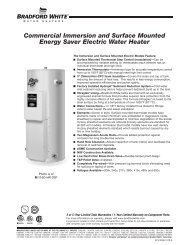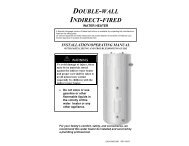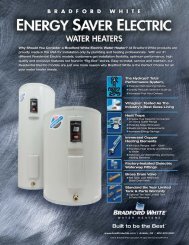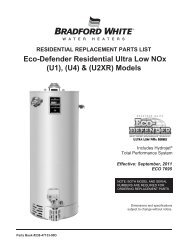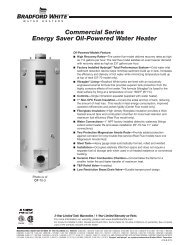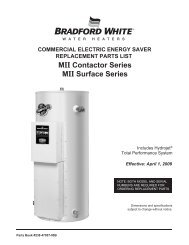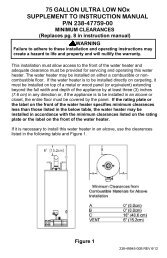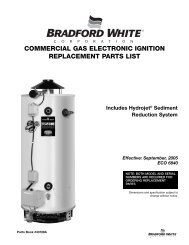238-47104-00A - Bradford White
238-47104-00A - Bradford White
238-47104-00A - Bradford White
You also want an ePaper? Increase the reach of your titles
YUMPU automatically turns print PDFs into web optimized ePapers that Google loves.
TROUBLESHOOTINGQuick Step Plan to Hot Water1. TURN OFF power to water heater and check all wireconnections to insure they are tight and corrosion free.2. Turn power “ON” and determine that service voltage ispresent, and the high limit (ECO) has not actuated(see procedure on page 14).WARNINGHigh voltage exposure. Use caution whenmaking voltage checks to avoid personalinjury.3. Check for inoperative heating element (see procedure on page 15).4. Check for proper thermostat operation (see procedures beginning on page 16). NOTE: Thermostat testing proceduresassume items 2 and 3 above are in working order.SYMPTOM PROBABLE CAUSE CORRECTIVE ACTIONSERVICEPROCEDURENo Hot Water1. No Power to heater.2. Loose wire connections.3. Inoperative upper heating element.4. Inoperative upper thermostat.5. Open ECO.1. Check fuses or circuit breakers in servicepanel.2. Check all wire connections.3. Check heating element(s). Replace asneeded.4. Check thermostat(s) operation. Replace asneeded.5. Check ECO. Reset or replacethermostat(s) as needed.3. See Service ProcedureRE-II, Page 15.4. See Service ProcedureRE-III, Page 16.5. See Service ProcedureRE-I, Page 14.Not Enough HotWaterSlow Hot WaterRecovery1. Inoperative lower heating element.2. Thermostat(s) set to low.3. Inoperative thermostat(s).4. Loose wire connection.5. Sediment or lime build up on element(s).6. High demand period.7. Undersized heater.8. Very cold inlet water to heater.9. Plumbing connections reversed.10. Damaged dip tube.1. Sediment or lime build up on element(s).2. Loose wire connections.3. Inoperative thermostat(s).4. Derated heating element installed.1. Check heating element(s), replace asneeded.2. Increase thermostat setting.3. Check thermostat(s), replace as needed.4. Check all wire connection.5. Remove heating element(s) and check forlime build up.6. Reduce demand.7. Replace with larger heater.8. Temper water to heater.9. Correct plumbing connections.10. Check dip tube, replace as needed.1. Remove heating element(s) and check forlime build up.2. Check all wire connections.3. Check thermostat(s), replace as needed.4. Check terminal block of element for propervoltage and wattage rating.1. See Service ProcedureRE-II, Page 15.3. See Service ProcedureRE-III, Page 16.5. See Service ProcedureRE-VI, Page 34.10. See Service ProcedureRE-VII, Page 35.1. See Service ProcedureRE-VI, Page 34.3. See Service ProcedureRE-III, Page 16.Over HeatedWater orContinuesOperation1. Thermostat not in contact with tank.2. Grounded heating element(s).3. Thermostat set to high.4. Inoperative thermostat(s).5. Inoperative ECO.6. Undersized water heater.1. Position thermostat flush with tank surface.2. Check heating element(s). Replace asneeded.3. Adjust thermostat(s) to desired setting.4. Check thermostat(s), replace as needed.5. Check ECO, replace thermostat asneeded.6. Replace with larger heater.1. See Service ProcedureRE-V, Page 33.2. See Service ProcedureRE-II, Page 15.4. See Service ProcedureRE-III, Page 16.5. See Service ProcedureRE-I, Page 14.Noisy (singing orhissing) Elements1. Lime formation on elements. 1. Remove and clean heating elements.Replace as needed.1. See Service ProcedureRE-VI, Page 34.Page 1313



